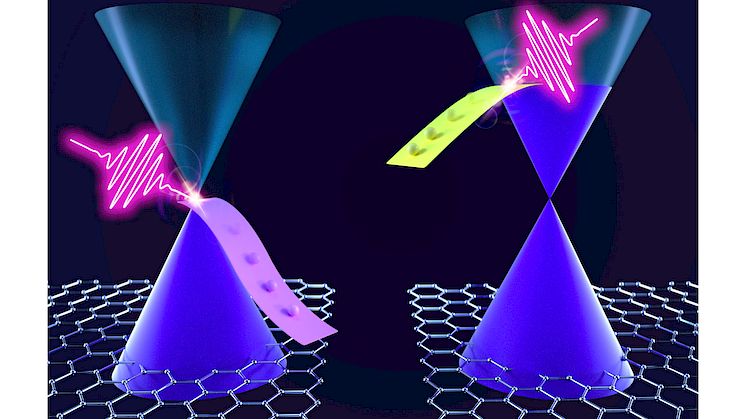
Press release -
Controlling how fast graphene cools down
Milano, 4th March 2022 – Graphene is the thinnest material ever produced, with the thickness of a single atomic layer, thinner than a billionth of a meter, it is able to efficiently absorb light from the visible to the infrared through the photoexcitation of its charge carriers. After light absorption, its photoexcited charge carriers cool down to the initial equilibrium state in a few picoseconds, corresponding to a millionth of a millionth of a second. The remarkable speed of this relaxation process makes graphene particularly promising for a number of technological applications, including light detectors, sources and modulators.
A recent study published in ACS Nano has shown that the relaxation time of graphene charge carriers can be significantly modified by applying an external electrical field. The research was conceived within an international collaboration between the CNR-IFN, Politecnico di Milano, the University of Pisa, the Graphene Center of Cambridge (UK) and ICN2 of Barcelona (Spain).
“The change in the relaxation time of charge carriers in graphene that we have observed, demonstrates an unprecedented level of control on the optical response of a crystal and allows to obtain a large variety of behaviors using a single material” says Eva Pogna, researched from CNR-IFN, first author of the work.
This work paves the way to the development of devices that exploit the control of the relaxation time of charge carriers to support novel functionalities. For example, if graphene is used as saturable absorber in a laser cavity to generate ultrashort light pulses, by changing the relaxation time of the charge carriers, we can control the duration of the output pulses.
“The specific device that we have used to study graphene, proved to be crucial to observe the strong tunability of its optical properties with the external electric field, allowing to change the number of charge carriers over a broad range by exploiting ionic liquid gating, which is a state-of-the-art technology introduced to study superconductors” explains Andrea Ferrari, director of the Graphene Center in Cambridge.
The graphene-based device has been studied by ultrafast spectroscopy, which allowed to monitor the variation of the relaxation time of the charge carriers.
“This work represents the latest step of a long-standing research collaboration devoted to the study of the ultrafast carrier dynamics in graphene, aimed at exploring the great potential of this fascinating material” as added by Klaas-Jan Tielrooij, leader of the Ultrafast Dynamics in Nanoscale Systems group at ICN2.
“This discovery is of large interest for a number of technological applications, ranging from photonics, for pulsed laser sources or optical limiters that prevent optical components damaging, to telecommunication, for ultrafast detectors and modulators” concludes Giulio Cerullo, professor of the Physics Department of Politecnico di Milano.
Link to research on ACS Nano: https://pubs.acs.org/doi/10.1021/acsnano.1c04937
Figure: Graphene charge carriers lying on different energetic levels represented by the Dirac cones, which, depending on the number of charge carriers, are occupied up to the neutrality point (blue level on the left cone) or well into the conduction band (blue level on the right cone). In the two cases, the photoexcited charge carriers relax with faster (left side) or slower (right side) dynamics.
Topics
Categories
Politecnico di Milano is a scientific-technological university which trains engineers, architects and industrial designers.
The University has always focused on the quality and innovation of its teaching and research, developing a fruitful relationship with business and productive world by means of experimental research and technological transfer.
Research has always been linked to didactics and it is a priority commitment which has allowed Politecnico Milano to achieve high quality results at an international level as to join the university to the business world. Research constitutes a parallel path to that formed by cooperation and alliances with the industrial system.
Knowing the world in which you are going to work is a vital requirement for training students. By referring back to the needs of the industrial world and public administration, research is facilitated in following new paths and dealing with the need for constant and rapid innovation. The alliance with the industrial world, in many cases favored by Fondazione Politecnico and by consortiums to which Politecnico belong, allows the university to follow the vocation of the territories in which it operates and to be a stimulus for their development.
The challenge which is being met today projects this tradition which is strongly rooted in the territory beyond the borders of the country, in a relationship which is developing first of all at the European level with the objective of contributing to the creation of a single professional training market. Politecnico takes part in several research, sites and training projects collaborating with the most qualified European universities. Politecnico's contribution is increasingly being extended to other countries: from North America to Southeast Asia to Eastern Europe. Today the drive to internationalization sees Politecnico Milano taking part into the European and world network of leading technical universities and it offers several courses beside many which are entirely taught in English.

